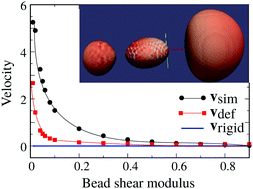Effect of body deformability on microswimming†
Abstract
In this work we consider the following question: given a mechanical microswimming mechanism, does increased deformability of the swimmer body hinder or promote the motility of the swimmer? To answer this we run immersed-boundary-lattice-Boltzmann simulations of a microswimmer composed of deformable beads connected with springs. We find that the same deformations in the beads can result in different effects on the swimming velocity, namely an enhancement or a reduction, depending on the other parameters. To understand this we determine analytically the velocity of the swimmer, starting from the forces driving the motion and assuming that the deformations in the beads are known as functions of time and are much smaller than the beads themselves. We find that to the lowest order, only the driving frequency mode of the surface deformations contributes to the swimming velocity, and comparison to the simulations shows that both the velocity-promoting and velocity-hindering effects of bead deformability are reproduced correctly by the theory in the limit of small bead deformations. For the case of active deformations we show that there are critical values of the spring constant – which for a general swimmer corresponds to its main elastic degree of freedom – which decide whether the body deformability is beneficial for motion or not.



 Please wait while we load your content...
Please wait while we load your content...